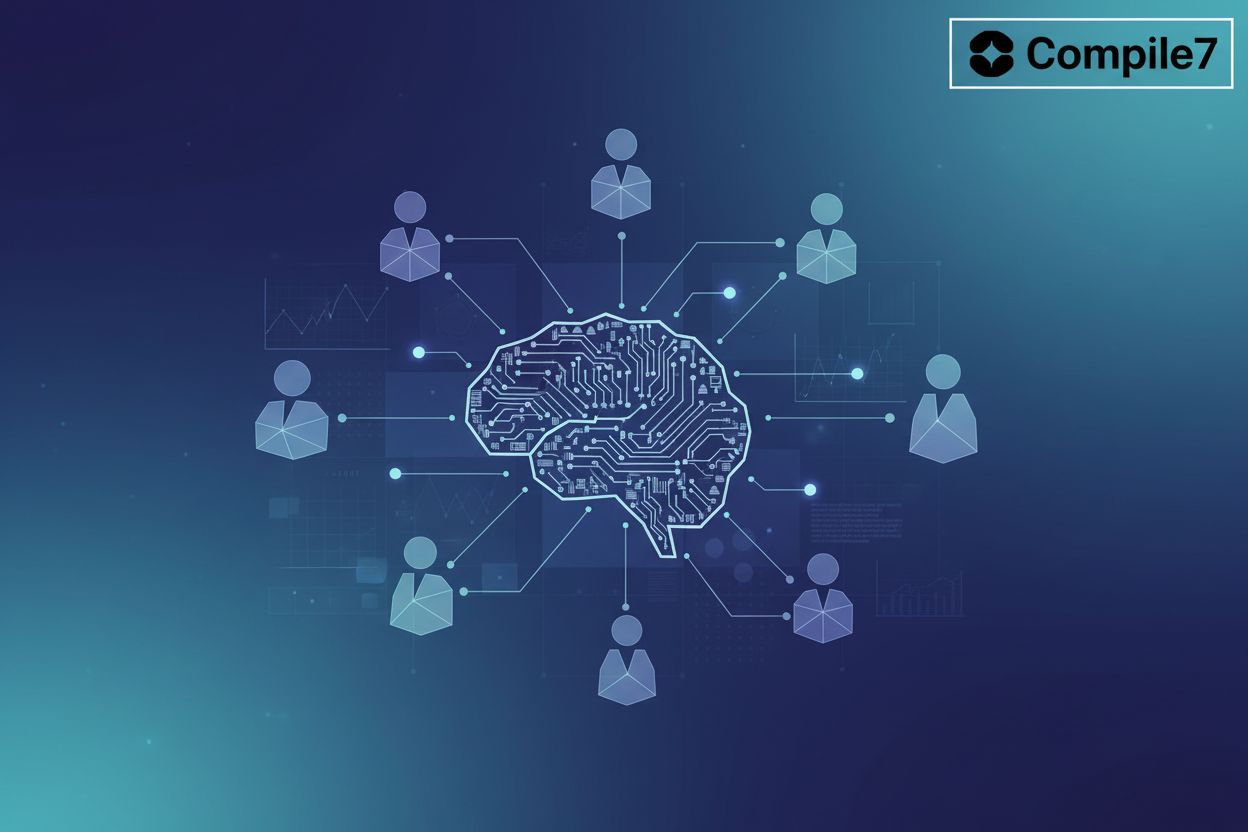Decoding AI Agent Architectures ReAct, Reflexion, and Beyond
TL;DR
Understanding AI Agents and Their Core Architectures
AI agents, pretty cool, right? But what are they, really? Think of them as the brains behind the operation, making decisions and taking actions to achieve specific goals – all without constant hand-holding.
- Autonomy is key. ai agents aren't just following orders; they're figuring out the best way to get things done, like a self-driving car navigating traffic.
- They interact with their environment, sensing and responding to changes, much like a customer service chatbot adapting to different user queries.
- Goal-oriented behavior drives everything. ai agents are designed to achieve specific objectives, whether it's optimizing a supply chain or diagnosing a medical condition.
ai agents aren't magic; they're built on some key architectural components.
- Perception is how the agent takes in information, like a robot using sensors to "see" its surroundings.
- Reasoning involves processing that information to make decisions, similar to a financial ai analyzing market trends.
- Action is what the agent does based on its reasoning – for example, a smart thermostat adjusting the temperature.
- Learning allows the agent to improve over time, like a recommendation system refining its suggestions based on user feedback. As aws highlights, learning agents adapt based on feedback.
Here's a simple way to visualize how these components interact:
So, that's a quick look at what ai agents are all about. Now, let's get into the nitty-gritty of how they're built.
ReAct: Reasoning and Acting in Tandem
ReAct, short for "Reasoning and Acting," is a pretty neat way to get ai agents to think and act more like humans. It's all about making them not just process information, but also show their work and learn from it.
- Core Idea: ReAct agents alternate between "thinking" (reasoning) and "doing" (acting). They don't just jump to a conclusion; they break it down.
- How it Works:
- Thought: The agent first generates a "thought" – essentially, an internal monologue or a plan of action. This thought might be about what information it needs, what step to take next, or how to interpret something.
- Action: Based on the thought, the agent then performs an "action." This could be querying a tool (like a search engine), asking a clarifying question, or making a decision.
- Observation: After the action, the agent receives an "observation" – the result of its action.
- Repeat: The agent then uses this observation to generate a new thought, and the cycle continues until the goal is reached.
- Example: Imagine asking an ai agent to find the capital of France.
- Thought: "I need to find the capital of France. I can use a search engine."
- Action:
search("capital of France") - Observation: "Paris is the capital of France."
- Thought: "I have the answer. The capital of France is Paris."
- Action:
finish("Paris")
- Relationship to Other Architectures: ReAct is a specific pattern or methodology that can be implemented within broader architectural frameworks. It's not a standalone architecture in the same way as "Reactive" or "Deliberative," but rather a way to imbue those architectures with more sophisticated reasoning and iterative problem-solving capabilities. It's particularly useful for tasks requiring exploration and dynamic decision-making.
Reflexion: Learning from Past Mistakes
Reflexion is another powerful design pattern that helps ai agents become more robust by learning from their errors. It's like giving your ai a memory of its failures and the ability to correct course.
- Core Idea: Reflexion agents maintain a "memory" of their past attempts and outcomes, especially focusing on failures. When they encounter a problem, they first check their memory to see if they've faced something similar and, if so, how they failed.
- How it Works:
- Problem Encounter: The agent is presented with a task or query.
- Memory Check: The agent consults its "reflection memory" to see if it has relevant past experiences. This memory stores information about previous attempts, the actions taken, and the outcomes, particularly focusing on errors.
- Reasoning/Planning: Based on the memory check, the agent either proceeds with a new plan or modifies its existing approach. If a similar past attempt failed, it will try to avoid the same mistakes.
- Action & Observation: The agent takes an action and observes the result.
- Reflection: If the action leads to an error or an undesirable outcome, the agent updates its reflection memory with this new information, essentially learning from the mistake.
- Example: Consider an ai agent trying to solve a complex coding problem.
- Attempt 1: The agent tries a certain approach, but it results in a bug.
- Reflection: The agent stores this failed attempt and the specific error in its memory.
- Attempt 2: When faced with a similar coding challenge, the agent recalls the previous failure and actively avoids the same buggy code pattern, leading to a successful solution.
- Relationship to Other Architectures: Like ReAct, Reflexion is a design pattern that enhances agent capabilities. It can be integrated into deliberative or hybrid architectures to add a layer of self-correction and learning from experience. It's a more advanced form of learning that goes beyond simple trial-and-error by explicitly storing and recalling past failures.
Reactive Architectures: Simplicity and Responsiveness
Reactive architectures? They're like the most basic ai agents you can get—think simple and quick.
- These agents respond directly to whatever's happening around them. No thinking, just reacting.
- They use predefined rules: If X happens, do Y. Like a thermostat—it's cold, turn on the heat.
- They don't remember anything or plan ahead. It is what it is, right now.
Think of traffic lights – sensors detect cars, lights change. Simple! Next, we'll look at more complex architectures.
Deliberative Architectures: Planning and Reasoning
Deliberative architectures, pretty interesting, right? They're all about thinking before acting – a bit like planning a road trip before just driving off.
- Planning is key. Deliberative agents don't just react; they create plans to achieve their goals. For example, in supply chain management, they might plan out the most efficient delivery routes considering traffic, weather, and whatnot.
- They evaluate different options, weighing the pros and cons of each action. Think of a financial ai deciding between different investment strategies, carefully considering the risk and potential return of each.
- Future states matter. These agents consider the long-term consequences of their actions. Like, a robot designed to clean a warehouse might plan its route to minimize energy consumption over the entire shift.
So, that's how deliberative architectures roll. They're good for tasks where you need to think ahead.
Hybrid Architectures: Combining Reactive and Deliberative Approaches
Hybrids? Bet you're wondering what the fuss is about. Well, it's about gettin' the best of both worlds, really.
- Hybrid architectures combines reactive (quick response) and deliberative (planning) approaches.
- Think of it like this: immediate actions plus long-term goals.
- This means balancing speed and adaptability is key.
- For example, in robotics, a hybrid agent might react quickly to avoid obstacles while still planning out it's overall route.
This approach allows agents to be both nimble in the moment and strategic over time.
Neural-Symbolic Architectures: Bridging Neural Networks and Symbolic Reasoning
Neural-symbolic architectures, they're pretty neat. It's like merging the best parts of two different worlds to create something even better.
- Neural networks handle pattern recognition, kinda like how your brain recognizes faces. They're great at learning from raw data and identifying complex patterns.
- Symbolic reasoning deals with logical inference, so it's like a computer using if-then statements to solve problems. This allows for clear, explainable reasoning and manipulation of abstract concepts.
- Integration Mechanisms: The magic happens in how these two are connected. This can involve:
- Neural networks learning symbolic rules: A neural network might be trained to extract logical rules from data.
- Symbolic systems guiding neural networks: A symbolic planner could dictate what kind of patterns a neural network should look for.
- Hybrid representations: Data can be represented in a way that both neural and symbolic systems can process.
- Benefits: This combination offers the best of both worlds: the learning power of neural networks and the explainability and logical rigor of symbolic systems. It's useful for tasks that require both understanding complex, unstructured data and performing precise, logical operations.
Next, let's look at some use cases.
Cognitive Architectures: Simulating Human-Like Thinking
Want ai that really thinks like us? Cognitive architectures are tryin' to do just that!
- They model stuff like memory, attention, and how we make choices. They aim to replicate the complex processes that underpin human cognition.
- Think of systems like ACT-R or Soar; they're used in virtual assistants and to solve tricky problems by trying to mimic human problem-solving strategies.
- It's about makin' ai more human, less robot, and that's pretty cool.
Next, we'll dig into advanced design patterns.
Advanced Agentic Design Patterns in Action
Did you ever wish your ai could, like, double-check its work? Turns out, there's ways to make that happen! We're gonna dig into advanced agentic design patterns, focusing on how agents can reflect and critique their own actions.
- ReAct and Reflexion: As we've seen, ReAct allows agents to interleave reasoning and action, while Reflexion enables them to learn from past mistakes. These are crucial for building more robust and adaptable agents.
- Tree of Thoughts (ToT): This is another advanced pattern. Instead of just a linear chain of thoughts like in ReAct, ToT explores a "tree" of possible reasoning paths. It's like brainstorming multiple ideas and evaluating them before committing to one. This allows for more creative problem-solving and exploration of different solution branches.
- Multi-Agent Systems: Think of it as a team of ai agents, working together. They can cooperate to solve problems, like a bunch of chatbots handling different parts of a customer query. Some even form networks or hierarchies, Vipra Singh explains that multi-agent systems can be designed in LangGraph.
So, ready to see how these patterns work in real life? Next, we'll dive into real-world applications.
Real-World Applications and Use Cases
AI agents? They're not just sci-fi anymore; they're changing how businesses operate. Here's the lowdown.
- ai agents are automating customer service, answering questions and resolving issues 24/7. They can handle a surprising amount of complexity, freeing up human agents for more critical tasks.
- They're analyzing big data to find trends and help businesses make smarter decisions. This can range from market analysis to predicting equipment failures.
- And they're even creating content, like social media posts and marketing copy. Some can even help with coding or drafting reports.
- Multi-Agent Systems in Action: In complex simulations or collaborative environments, multiple agents can work together. For instance, in a logistics simulation, one agent might manage inventory, another delivery routes, and a third customer interactions, all coordinating to optimize the overall process.
Next up: The importance of custom AI development.
The Importance of Custom AI Development
Custom ai development? It's more important than you might think for getting real business value.
- Generic ai solutions often miss the mark. You needs something tailored to your specific problems and data.
- Custom solutions allow for seamless integration with existing systems. Think less headaches and more smooth sailing.
- Tailored ai means better efficiency and happier customers down the line. It's about building exactly what you need, not making do with something that's "close enough."
So, ready to see how this plays out? Next, let's talk challenges and future trends.
Challenges and Future Trends in AI Agent Architectures
Are ai agents living up to the hype? Well, not quite yet, but we're gettin' there! There's still some bumps in the road ahead.
- Ensuring Fairness, Transparency, and Mitigating Biases: These are closely related. We gotta make sure these agents ain't biased and that we understand why they're makin' the decisions they are. If the data used to train the ai is skewed, the agent will be too. Future work is focusing on explainable ai (XAI) techniques and robust bias detection/correction methods.
- Advancements in AI and Machine Learning (ML): These are constantly pushin' the boundaries of what these agents can do. Think better natural language processing (NLP) for understanding nuanced requests, more sophisticated reinforcement learning for decision-making, and improved few-shot learning for adapting to new tasks quickly.
- Integration of AI Agents with Other Technologies: This is gonna be huge. Imagine agents workin' seamlessly with IoT devices for real-time environmental control, blockchain for secure data sharing, or advanced robotics for physical tasks. This integration will unlock new levels of automation and intelligence.
- Scalability and Efficiency: As agents become more complex, ensuring they can operate efficiently and scale to handle massive amounts of data and requests is a major challenge.
There are a lot of moving parts here and it will be exciting. Getting past these challenges will be key to unlocking their full potential.







